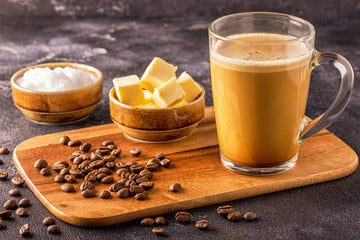Beef tallow, also known as suet, is a valuable fat obtained by melting beef fat. Originally a staple in traditional cuisines around the world, it faded into the background with the introduction of vegetable oils. Today, this nutrient-rich natural product is experiencing a renaissance - both in the kitchen and in skin care.
Rendering, i.e. the slow heating of raw fatty tissue, separates the solid components from the pure fat. The result is a stable, white fat that keeps for a long time at room temperature. Its neutral taste and versatility make beef tallow an excellent choice for health-conscious and sustainably oriented people.
nutritional values and health benefits
Beef tallow is rich in healthy fatty acids and nutrients that support the body. The saturated fatty acids in particular make this fat stable and ideal for cooking at high temperatures. Grass-fed cattle also provide valuable vitamin K2, which promotes bone health by regulating calcium absorption.
A balanced ratio of omega-3 and omega-6 fatty acids can help reduce inflammation and support cellular health. Unlike many processed fats, beef tallow contains no trans fats or artificial additives, making it a natural and unadulterated source of energy. It is particularly valued in low-carb and carnivore diets for its high fat content, which provides long-lasting energy and prevents cravings.
Beef Tallow in the Kitchen
Beef Tallow is a real all-rounder on the stove. Thanks to its high smoke point, it is ideal for frying and deep-frying. It gives dishes a hearty note without masking the natural flavor of the ingredients.
Beef tallow used to be the standard ingredient for making French fries, and today connoisseurs are using it again for this purpose. It is also ideal for frying meat or vegetables and even for making baked goods. Its stable fat content ensures even cooking and an appetizing browning. If you like to experiment, you can use beef tallow as a butter substitute in savory recipes and be surprised by its intense aroma.
Beef Tallow as a natural skin care product
Beef tallow is an insider tip not only in the kitchen, but also in skin care. Its composition is similar to the natural lipids in our skin, which means it is particularly well absorbed. It moisturizes, soothes irritated skin and supports regeneration.
A tallow balm is easy to make at home: slowly melt beef tallow and add a few drops of essential oil such as lavender or tea tree. The result is a nourishing balm that is free of synthetic additives and is ideal for dry skin or chapped lips.
Unlike many conventional skincare products, Beef Tallow is completely natural and sustainable. It protects the skin without overloading it and leaves it feeling soft and supple.
sustainability and nose-to-tail principle
The use of beef tallow is a prime example of sustainable nutrition and the nose-to-tail approach, which attempts to utilize all parts of the animal to minimize food waste.
By using beef tallow as a valuable by-product, it contributes to the efficiency of meat production. Many butchers and regional farms offer beef tallow from grass-fed animals, which not only improves quality but also promotes the local economy. Anyone who consciously chooses beef tallow supports sustainable and resource-saving food production.
A natural product with history and future
Beef tallow is more than just a traditional fat - it is a versatile, sustainable and healthy product that shines in both the kitchen and skin care. Its rich nutrient profile, stability at high temperatures and easy storage make it an ideal companion for conscious nutrition and natural care.
At a time when sustainability and health are becoming increasingly important, beef tallow offers a way to combine tradition and modernity. Whether when frying a juicy steak or as a nourishing balm - this natural product deserves a permanent place in everyday life.





